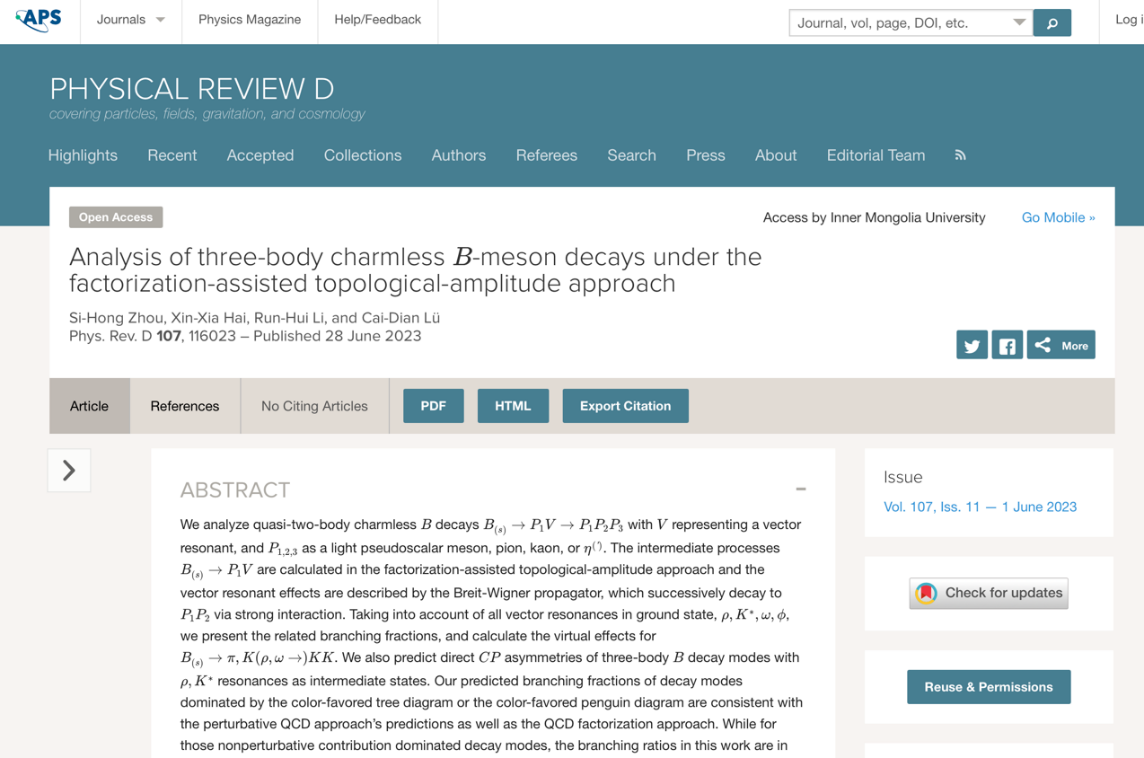Recently, Associate Prof. Zhou Sihong with the School of Physical Science and Technology of IMU, has published, in the international top physical journal-Physical Review D whose effect factor issued by Clarivate is 5.0 and that is in the first section of WOS journal categorization, the latest research results in the three-body charmless heavy B-meson decays. The article is titled “Analysis of three-body charmless B-meson decays under the factorization-assisted topological-amplitude approach”. The url of the article is https://journals.aps.org/prd/abstract/10.1103/PhysRevD.107.116023.
The three-body charmless heavy B-meson decay is very important in precisely examining standard model, further understanding strong interactions and studying CP violation. In theoretical calculation, the three-body charmless B-meson decay concerns low-scaling QCD effect. As a result, it is hard to have a perturbation calculation for it. At present, the main research methods for three-body charmless B-meson decay include the perturbative QCD approach and factorization hypothesis. Such observable values as branching ratio and CP violation in the calculation with the above-mentioned approaches do not well conform to the values from the experiments and they are much smaller than the values measured in the experiments. And the error from the calculations is huge. Considering the accuracy and precision of the result of theoretical calculation, the authors of the article has used a new approach- the factorization-assisted topological-amplitude approach(FAT) to study the three-body charmless B-meson decays.
FAT is an approach that uses the existing experimental data to fit as a whole non-perturbative QCD contributions. Therefore, it is non-model related. First, according to the approach, the contribution plot of the charmless B-meson decay is categorized as different topological graphs on the basis of weak interaction. As a result, all the information of strong interaction(including non-perturbative contributions ) is included the topological graphs. Second, considering the violation effect of SU(3) flavor symmetry, the authors of the article,with FAT, factorize the factors that characterize the violation effect of SU(3), such as the decay constant in decay amplitude and form factors. Then, the left contribution that cannot be factorized is not related to the process. Thus, the contributions that cannot be factorized in the same topological graph amplitude in decays can be represented with the same parameters to hugely reduce the number of free parameters that is to be fitted and the theoretical error and make the results independent, to a large extent, from the input of theoretical parameters. The authors of the article use FAT to calculate the branching ratio and the corresponding CP violation in the three-body charmless B-meson decays. The calculation results in the article agree well with the existing experimental results and are the most accurate at present. The article predicts the branching ratio of the decay channels that has not been measured in experiment, which provides a reference for such experiments as LHCb and Belle-II.
Zhou Sihong is the first author and corresponding author of the article. Hai Xinxia, a master student of Zhou Sihong’s research team is the second author and Prof. Li Runhui with the School of Physical Science and Technology of IMU the third author. Inner Mongolia University is the institution which the first author and corresponding author is with. Zhou Sihong, the first and corresponding author of the article is supported by the Project of Inner Mongolia University for Newly Joined High-Level Talents and the National Natural Science Foundation of China(Grant No. 12105148). And Li Runhui is supported by the National Natural Science Foundation of China(Grant No. 12075126).


